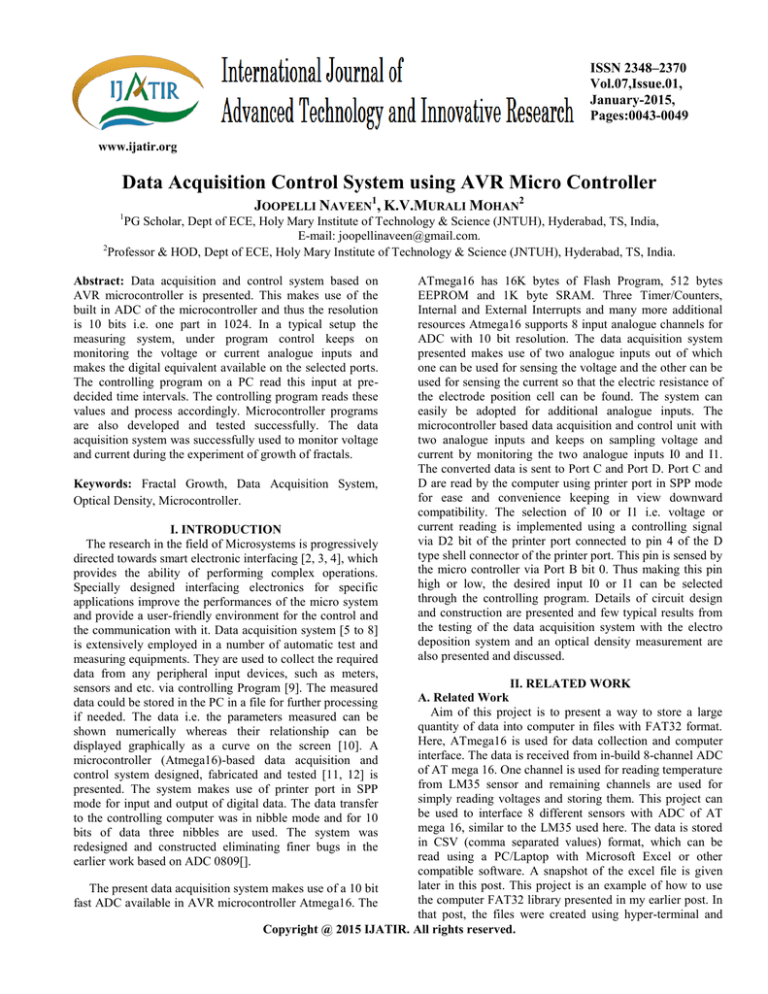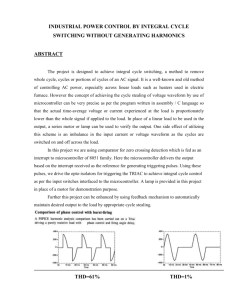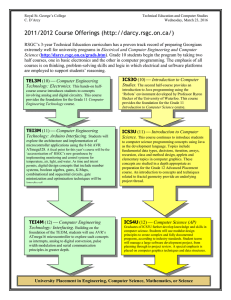
ISSN 2348–2370
Vol.07,Issue.01,
January-2015,
Pages:0043-0049
www.ijatir.org
Data Acquisition Control System using AVR Micro Controller
JOOPELLI NAVEEN1, K.V.MURALI MOHAN2
1
PG Scholar, Dept of ECE, Holy Mary Institute of Technology & Science (JNTUH), Hyderabad, TS, India,
E-mail: joopellinaveen@gmail.com.
2
Professor & HOD, Dept of ECE, Holy Mary Institute of Technology & Science (JNTUH), Hyderabad, TS, India.
Abstract: Data acquisition and control system based on
AVR microcontroller is presented. This makes use of the
built in ADC of the microcontroller and thus the resolution
is 10 bits i.e. one part in 1024. In a typical setup the
measuring system, under program control keeps on
monitoring the voltage or current analogue inputs and
makes the digital equivalent available on the selected ports.
The controlling program on a PC read this input at predecided time intervals. The controlling program reads these
values and process accordingly. Microcontroller programs
are also developed and tested successfully. The data
acquisition system was successfully used to monitor voltage
and current during the experiment of growth of fractals.
Keywords: Fractal Growth, Data Acquisition System,
Optical Density, Microcontroller.
I. INTRODUCTION
The research in the field of Microsystems is progressively
directed towards smart electronic interfacing [2, 3, 4], which
provides the ability of performing complex operations.
Specially designed interfacing electronics for specific
applications improve the performances of the micro system
and provide a user-friendly environment for the control and
the communication with it. Data acquisition system [5 to 8]
is extensively employed in a number of automatic test and
measuring equipments. They are used to collect the required
data from any peripheral input devices, such as meters,
sensors and etc. via controlling Program [9]. The measured
data could be stored in the PC in a file for further processing
if needed. The data i.e. the parameters measured can be
shown numerically whereas their relationship can be
displayed graphically as a curve on the screen [10]. A
microcontroller (Atmega16)-based data acquisition and
control system designed, fabricated and tested [11, 12] is
presented. The system makes use of printer port in SPP
mode for input and output of digital data. The data transfer
to the controlling computer was in nibble mode and for 10
bits of data three nibbles are used. The system was
redesigned and constructed eliminating finer bugs in the
earlier work based on ADC 0809[].
ATmega16 has 16K bytes of Flash Program, 512 bytes
EEPROM and 1K byte SRAM. Three Timer/Counters,
Internal and External Interrupts and many more additional
resources Atmega16 supports 8 input analogue channels for
ADC with 10 bit resolution. The data acquisition system
presented makes use of two analogue inputs out of which
one can be used for sensing the voltage and the other can be
used for sensing the current so that the electric resistance of
the electrode position cell can be found. The system can
easily be adopted for additional analogue inputs. The
microcontroller based data acquisition and control unit with
two analogue inputs and keeps on sampling voltage and
current by monitoring the two analogue inputs I0 and I1.
The converted data is sent to Port C and Port D. Port C and
D are read by the computer using printer port in SPP mode
for ease and convenience keeping in view downward
compatibility. The selection of I0 or I1 i.e. voltage or
current reading is implemented using a controlling signal
via D2 bit of the printer port connected to pin 4 of the D
type shell connector of the printer port. This pin is sensed by
the micro controller via Port B bit 0. Thus making this pin
high or low, the desired input I0 or I1 can be selected
through the controlling program. Details of circuit design
and construction are presented and few typical results from
the testing of the data acquisition system with the electro
deposition system and an optical density measurement are
also presented and discussed.
II. RELATED WORK
A. Related Work
Aim of this project is to present a way to store a large
quantity of data into computer in files with FAT32 format.
Here, ATmega16 is used for data collection and computer
interface. The data is received from in-build 8-channel ADC
of AT mega 16. One channel is used for reading temperature
from LM35 sensor and remaining channels are used for
simply reading voltages and storing them. This project can
be used to interface 8 different sensors with ADC of AT
mega 16, similar to the LM35 used here. The data is stored
in CSV (comma separated values) format, which can be
read using a PC/Laptop with Microsoft Excel or other
compatible software. A snapshot of the excel file is given
later in this post. This project is an example of how to use
The present data acquisition system makes use of a 10 bit
the computer FAT32 library presented in my earlier post. In
fast ADC available in AVR microcontroller Atmega16. The
that post, the files were created using hyper-terminal and
Copyright @ 2015 IJATIR. All rights reserved.
JOOPELLI NAVEEN, K.V.MURALI MOHAN
entering data with the PC keyboard, since that demonstrates
project can be used to interface 8 different sensors with
the file creation and it's easy to debug. RTC interface (for
ADC of AT mega 16, similar to the LM35 used here. The
date and time storage), RS232 (for connection with PC) and
data is stored in CSV (comma separated values) format,
a computer module here, the hyper-terminal connection is
which can be read using a PC/Laptop with Microsoft Excel
required only for setting RTC date and time. Once the
or other compatible software.
date/time is set, the RS232 connection is not required
B. Proposed System
anymore for normal data-logging operation. It can be used
The data acquisition system was designed basically to
for debugging purpose if there is a problem.
monitor two analogue inputs under program control. In view
To complete our project we studied about embedded
of the downward compatibility, the printer port was used in
systems basics and system design cycle to know how to
SPP mode and the data acquisition was implemented in
develop the Microcontroller and Microprocessor based
nibble mode. To improve the precession of the voltage and
projects. Further we analyzed some of latest controllers‟
current measurements, suitable sensing approach was
architecture available in the market. Finally we selected AT
adopted and 10 bit ADC was selected. This was found
mega 16 controllers because of its features (it is discussed in
sufficient as the 10 bit ADC allows for a resolution of 1 part
hardware requirements). For our successful completion of
in 1024 which is sufficient for the present application and
this project obviously we utilized howstuffworks.com,
higher resolutions are not desired. To reduce the burden on
www.microchip.com, www.google.com, en.wikipedia.org.
the computer, the data acquisition was constructed using a
In this section some related works are discussed below.
microcontroller AT mega 16 from Atmel Corporation. This
The present data acquisition system makes use of a 10 bit
microcontroller has a built in Analogue to digital converter
fast ADC available in AVR microcontroller AT mega 16.
with 10 bit resolution and good capabilities. It has 8
The AT mega 16 has 16K bytes of Flash Program, 512 bytes
analogue input channels so that 8 analogue inputs can be
EEPROM and 1K byte SRAM. Three Timer/Counters,
monitored, however in the present
Internal and External Interrupts and many more additional
C. Block Diagram
resources AT mega 16 supports 8 input analogue channels
for ADC with 10 bit resolution. The data acquisition system
presented makes use of two analogue inputs out of which
one can be used for sensing the voltage and the other can be
used for sensing the current so that the electric resistance of
the electrodepositing cell can be found. The system can
easily be adopted for additional analogue inputs.
B. Literature Survey
The research in the field of Microsystems is progressively
directed towards smart electronic interfacing which provides
the ability of performing complex operations. Specially
designed interfacing electronics for specific applications
improve the performances of the micro system and provide
a user-friendly environment for the control and the
communication with it. Data acquisition system is
extensively employed in a number of automatic test and
measuring equipments. They are used to collect the required
data from any peripheral input devices, such as meters,
sensors and etc. via controlling Program. The measured data
could be stored in the PC in a file for further processing if
needed. The data i.e. the parameters measured can be shown
numerically whereas their relationship can be displayed
graphically as a curve on the screen.
III. EXISTING AND PROPOSED SYSTEMS
A. Existing System
This project is to present a way to store a large quantity of
data into computer in files with FAT32 format. Here, AT
mega 16 is used for data collection and computer interface.
The data is received from in-build 8-channel ADC of AT
mega 16. One channel is used for reading temperature from
LM35 sensor and remaining channels are used for simply
reading voltages and storing them as shown in Fig.1. This
Fig.1. Block Diagram.
D. Operation of the Circuit
The operation is very simple as it uses just one pushbutton and an LED indication. In case of any error in
accessing the card, red LED will blink continuously. In such
a case, you can start circuit in debug mode (with terminal)
and see the error messages. Files are stored with the date as
a name and .CSV extension. For example, data-logging
done on 10 May 2011 would be stored in "10052011.CSV"
file. Since the date is the name of file, everyday a single file
is created and all the data recording done in a day goes into
single file, no matter how many times the recording is
stopped/started. First column of the file shows date, second
shows time and next 8 columns show data from the 8
channels. A file created during testing is shown in the figure
below, where 5 sec interval was set for measurements (click
on the image to enlarge it). Here channel-0 was used for
LM35 temperature sensor, and remaining channels measure
voltage. 5v was connected to channel-1 and 3v Li cell was
connected to channel-3 (Channel 2 & 4 show some small
voltages due to noise from voltages connected to nearby
channels
International Journal of Advanced Technology and Innovative Research
Volume.07, IssueNo.01, January-2015, Pages: 0043-0049
Data Acquisition Control System using AVR Micro Controller
used as a rectifier but it only uses the positive (+) parts of
1. Power supply
There are many types of power supply. Most are
the AC wave to produce half-wave varying DC
designed to convert high voltage AC mains electricity to a
2. Micro Controller Unit
suitable low voltage supply for electronic circuits and other
The AVR core combines a rich instruction set with 32
devices. A power supply can by broken down into a series
general
purpose working registers. All the 32 registers are
of blocks, each of which performs a particular function as
directly connected to the Arithmetic Logic Unit (ALU),
shown in Fig.2.
allowing two independent registers to be accessed in one
single instruction executed in one clock cycle. The resulting
For example a 5V regulated supply:
architecture is more code efficient while achieving
throughputs up to ten times faster than conventional CISC
microcontrollers. The AT mega 16 provides the following
features: 16K bytes of In-System Programmable Flash
Program memory with Read-While-Write capabilities, 512
bytes EEPROM, 1K byte SRAM, 32 general purpose I/O
lines, 32 general purpose working registers, OnFig.2. Block diagram of a Regulated Power Supply.
chip Debugging support and programming, three flexible
Timer/Counters with compare modes, Internal and External
Each of the blocks is described in more detail below:
Interrupts, a serial programmable USART, a byte
oriented Two-wire Serial
Interface,
an 8-channel, 10Transformer - steps down high voltage AC mains to low
bit
ADC
with
optional
differential
input
stage with
voltage AC.
programmable gain (TQFP package only), a programmable
Watchdog Timer with Internal Oscillator, an SPI serial port,
Rectifier - converts AC to DC, but the DC output is varying.
and six software selectable power saving modes. The Idle
Smoothing - smoothes the DC from varying greatly to a
mode stops the CPU while allowing the USART, Twosmall ripple.
wire interface, A/D Converter, SRAM; Timer/Counters, SPI
port, and interrupt system to continue functioning.
Regulator - eliminates ripple by setting DC output to a fixed
The Power-down mode saves the register contents but
voltage.
freezes the Oscillator, disabling all other chip functions until
the next External Interrupt or Hardware Reset. In PowerTransformer: Transformers convert AC electricity from
save mode, the Asynchronous Timer continues to run,
one voltage to another with little loss of power.
allowing the user to maintain a timer base while the rest of
Transformers work only with AC and this is one of the
the device is sleeping.
reasons why mains electricity is AC. Step-up transformers
increase voltage, step-down transformers reduce voltage.
The ADC Noise Reduction mode stops the CPU and all
Most power supplies use a step-down transformer to reduce
I/O modules except Asynchronous Timer and ADC, to
the dangerously high mains voltage (230V in India) to a
minimize switching noise during ADC conversions. In
safer low voltage. The input coil is called the primary and
Standby mode, the crystal/resonator Oscillator is running
the output coil is called the secondary. There is no electrical
while the rest of the device is sleeping. This allows very
connection between the two coils; instead they are linked by
fast start-up combined with low-power consumption. In
an alternating magnetic field created in the soft-iron core of
Extended Standby mode, both the main Oscillator and the
the transformer. Transformers waste very little power so the
Asynchronous Timer continue to run. The device is
power out is (almost) equal to the power in. Note that as
manufactured using Atmel‟s high density non-volatile
voltage is stepped down current is stepped up. The
memory technology. The On chip ISP Flash allows the
transformer will step down the power supply voltage (0program memory to be reprogrammed in-system through an
230V) to (0- 6V) level. Then the secondary of the potential
SPI serial interface, by a conventional non-volatile memory
transformer will be connected to the bridge rectifier, which
programmer, or by an On-chip Boot program running on the
is constructed with the help of PN junction diodes. The
AVR core. The boot program can use any interface to
advantages of using bridge rectifier are it will give peak
download the application program in the Application Flash
voltage output as DC.
memory. Software in the Boot Flash section will continue to
run while the Application Flash section is updated,
Rectifier: There are several ways of connecting diodes to
providing true Read-While-Write operation. By combining
make a rectifier to convert AC to DC. The bridge rectifier is
an 8-bit RISC CPU with In-System Self-Programmable
the most important and it produces full-wave varying DC. A
Flash on a monolithic chip, the Atmel AT mega 16 is a
full-wave rectifier can also be made from just two diodes if
powerful
microcontroller that provides a highlya centre-tap transformer is used, but this method is rarely
flexible and cost-effective solution to many embedded
used now that diodes are cheaper. A single diode can be
control applications.
International Journal of Advanced Technology and Innovative Research
Volume.07, IssueNo.01, January-2015, Pages: 0043-0049
JOOPELLI NAVEEN, K.V.MURALI MOHAN
The AT mega 16 AVR is supported with a full suite of
0.1°C in still air. The LM35 is rated to operate over a −55°
program and system development tools including: C
to +150°C temperature range.
compilers, macro assemblers, program debugger /
Typical Applications:
simulators, in-circuit emulators, and evaluation kits as
shown in Fig.3.
(a)
Fig.3. Pin Diagram of ATmega 16.
3. MAX232
The MAX232 is an IC, first created by Maxim Integrated
Products, that converts signals from an RS-232 serial port to
signals suitable for use in TTL compatible digital logic
circuits. The MAX232 is a dual driver/receiver and typically
converts the RX, TX, CTS and RTS signals. The drivers
provide RS-232 voltage level outputs (approx. ± 7.5V) from
a single + 5V supply via on-chip charge pumps and external
capacitors. This makes it useful for implementing RS-232 in
devices that otherwise do not need any voltages outside the
0V to + 5V range, as power supply design does not need to
be made more complicated just for driving the RS-232 in
this case. The receivers reduce RS-232 inputs (which may
be as high as ± 25 V), to standard 5 VTTL levels. These
receivers have a typical threshold of 1.3 V, and a
typical hysteresis of 0.5 V.
4. Temperature Sensor LM35
The LM35 series are precision integrated-circuit
temperature sensors, whose output voltage is linearly
proportional to the Celsius (Centigrade) temperature. The
LM35 thus has an advantage over linear temperature sensors
calibrated in ° Kelvin, as the user is not required to subtract
a large constant voltage from its output to obtain convenient
Centigrade scaling. The LM35 does not require any external
calibration or trimming to provide typical accuracies of
±1⁄4°C at room temperature and ±3⁄4°C over a full −55 to
+150°C temperature range as shown in Fig.4. Low cost is
assured by trimming and calibration at the wafer level. The
LM35‟s low output impedance, linear output, and precise
inherent calibration make interfacing to readout or control
circuitry especially easy. It can be used with single power
supplies, or with plus and minus supplies. As it draws only
60 μA from its supply, it has very low self-heating, less than
(b)
Fig.4. Applications of Lm35.
5. LCD Unit
(LCD) has material which combines the properties of
both liquid and crystals. They have a temperature range
within which the molecules are almost as mobile as they
would be in a liquid, but are grouped together in an order
form similar to a crystal as shown in Fig.5.
Fig.5. LCD Display.
More microcontroller devices are using 'smart LCD'
displays to output visual information. The following
discussion covers the connection of a Hitachi LCD display
to a LPC2148 microcontroller. LCD displays designed
around Hitachi's LCD HD44780 module, are inexpensive,
easy to use, and it is even possible to produce a readout
using the 8 x 80 pixels of the display. Hitachi LCD displays
have a standard ASCII set of characters plus Japanese,
Greek and mathematical symbols. For an 8-bit data bus, the
display requires a +5V supply plus 11 I/O lines. For a 4-bit
data bus it only requires the supply lines plus seven extra
lines. When the LCD display is not enabled, data lines are
tri-state which means they are in a state of impedance (as
though they are disconnected. The LCD also requires 3
"control" lines from the microcontroller.
International Journal of Advanced Technology and Innovative Research
Volume.07, IssueNo.01, January-2015, Pages: 0043-0049
Data Acquisition Control System using AVR Micro Controller
asynchronous serial data communication, this baud rate is
6.Asynchronous and Synchronous Serial Communicagenerally limited to 100,000bps. The baud rate is fixed to
tion
Computers transfer data in two ways: parallel and serial.
9600bps in order to interface with the microcontroller using
In parallel data transfers, often 8 or more lines are used to
a crystal of 11.0592 MHz.
transfer data to a device that is only a few feet away.
7. RS232 Cable
Although a lot of data can be transferred in a short amount
To allow compatibility among data communication
of time by using many wires in parallel, the distance cannot
equipment, an interfacing standard called RS232 is used.
be great. To transfer to a device located many meters away,
Since the standard was set long before the advent of the
the serial method is best suitable. In serial communication,
TTL logic family, its input and output voltage levels are not
the data is sent one bit at a time. The 8051 has serial
TTL compatible. For this reason, to connect any RS232 to a
communication capability built into it, thereby making
microcontroller system, voltage converters such as
possible fast data transfer using only a few wires. The fact
MAX232 are used to convert the TTL logic levels to the
that serial communication uses a single data line instead of
RS232 voltage levels and vice versa.
the 8-bit data line instead of the 8-bit data line of parallel
communication not only makes it cheaper but also enables
8. ADC0816
two computers located in two different cities to
The ADC0816, ADC0817 data acquisition component is
communicate over the telephone.
a monolithic CMOS device with an 8-bit analog-to digital
converter, 16-channel multiplexer and microprocessor
Serial data communication uses two methods,
compatible control logic. The 8-bit A/D converter uses
asynchronous and synchronous. The synchronous method
successive approximation as the conversion technique. The
transfers a block of data at a time, while the asynchronous
converter features a high impedance chopper stabilized
method transfers a single byte at a time. With synchronous
comparator, a 256R voltage divider with analog switch tree
communications, the two devices initially synchronize
and a successive approximation register. The 16-channel
themselves to each other, and then continually send
multiplexer can directly access any one of 16-single- ended
characters to stay in sync. Even when data is not really
analog signals, and provides the logic for additional channel
being sent, a constant flow of bits allows each device to
expansion. Signal conditioning of any analog input signal is
know where the other is at any given time. That is, each
eased by direct access to the multiplexer output, and to the
character that is sent is either actual data or an idle
input of the 8-bit A/D converter. The device eliminates the
character. Synchronous communications allows faster data
need for external zero and full-scale adjustments. Easy
transfer rates than asynchronous methods, because
interfacing to microprocessors is provided by the latched
additional bits to mark the beginning and end of each data
and decoded multiplexer address inputs and latched TTL
byte are not required. The serial ports on IBM-style PCs are
TRI-STATE outputs.
asynchronous devices and therefore only support
asynchronous serial communications. Asynchronous means
The design of the ADC0816, ADC0817 has been
"no synchronization", and thus does not require sending and
optimized by incorporating the most desirable aspects of
receiving idle characters. However, the beginning and end
several A/D conversion techniques. The ADC0816,
of each byte of data must be identified by start and stop bits.
ADC0817 offers high speed, high accuracy, minimal
temperature dependence, excellent long-term accuracy and
The start bit indicates when the data byte is about to begin
repeatability, and consumes minima low power as shown in
and the stop bit signals when it ends. The requirement to
Fig.6. These features make this device ideally suited to
send these additional two bits causes asynchronous
applications from process and machine control to consumer
communication to be slightly slower than synchronous
and automotive applications. For similar performance in an
however it has the advantage that the processor does not
8-channel, 28-pin, 8-bit A/D converter, see the ADC0808,
have to deal with the additional idle characters. There are
ADC0809 data sheet. (See AN-258 for more information)
special IC chips made by many manufacturers for serial data
communications. These chips are commonly referred to as
UART(universal asynchronous receiver-transmitter) and
USART(universal synchronous-asynchronous receivertransmitter). The 8051 has a built-in UART. In the
asynchronous method, the data such as ASCII characters are
packed between a start and a stop bit. The start bit is always
one bit, but the stop bit can be one or two bits. The start bit
is always a 0 (low) and stop bit (s) is 1 (high). This is called
framing. The rate of data transfer in serial data
communication is stated as bps (bits per second). Another
widely used terminology for bps is baud rate. The data
transfer rate of a given computer system depends on
communication ports incorporated into that system. And in
Fig.6. ADC 0816.
International Journal of Advanced Technology and Innovative Research
Volume.07, IssueNo.01, January-2015, Pages: 0043-0049
IV. RESULTS
A. Circuit Diagram
JOOPELLI NAVEEN, K.V.MURALI MOHAN
data is received from in-build ADC channels of
microcontroller as shown in Figs. 8 to 10. One channel is
used for reading input AC voltage and one more channel is
used for reading output DC voltage and storing them.
The data is stored in CSV (comma separated values)
format, which can be read using a PC/Laptop with
Microsoft Excel or other compatible software. Files are
stored with the date as a name and .CSV extension. For
example, data-logging done on 10 May 2014 would be
stored in "10052014.CSV" file. Since the date is the name
of file, everyday a single file is created and all the data
recording done in a day goes into single file, no matter how
many times the recording is stopped/started. The project
contains RTC interface (for date and time storage), RS232
(for connection with PC). Here, the hyper-terminal
connection is required only for setting RTC date and time.
Once the date/time are set, the RS232 connection is not
required anymore for normal data-logging operation (It can
be used for debugging purpose if there is a problem.
Fig.8. Initial kit.
Fig.7. circuit diagram.
Circuit Diagram Description: Here we are using AVR
MICRO-controller. The LCD is connected to the PORT-B
as shown in Fig.7. We are using 4-bit LCD. So we used
only 4-data lines. The register select is connected to the
P0.17 and enable is connected to P0.18. So whatever the
data we want we can display it on LCD. The controller uses
three sensors such as temperature sensor (lm35), LDR (light
dependent register), and variable resistor. The
microcontroller monitors continuously various parameters
using the above mentioned sensors.
We present Microcontroller-based moving-message
display that uses a 16×2 LCD display incorporating
HD44780. The 16×2 LCD can display 16 characters per line
and there are two such lines and a way to store a large
quantity of data into files with FAT32 format. Here,
microcontroller is used for data collection and interface. The
Fig.9. Data Acquisition of room temperature.
International Journal of Advanced Technology and Innovative Research
Volume.07, IssueNo.01, January-2015, Pages: 0043-0049
Data Acquisition Control System using AVR Micro Controller
[8] R. F. Graf „The encyclopedia of Electronic circuits‟
(BPB Publication):(New Delhi) (First Indian Edition) 1989.
[9] A. Sagahyroon, T. Al-khudairi, ”FPGA Based
Acquisition of Sensor Data” Proc. of Int. Conf. on Ind.
Tech., ICIT 2004 :1398.
[10] S. Thanee S. Somkuarnpanit and K. Saetang, “FPGABased Multi Protocol Data Acquisition System with High
Speed USB Interface” Proceedings of the international
Multi Conference of Engineers and Computer Scientists
2010 Vol II, IMCES 2010, 17,Hong Kong.
[11] V.G. Sangam, B.M. Patre, Jl. of In strum. Soc. of India
2009 39(1):30.
[12] P. Asimakopoulos, G. Kaltsas and A. G. Nassiopoulou,
„A microcontroller- based interface circuit for data
acquisition and control of a micromechanical thermal flow
sensor‟ Institute of Physics Publishing Journal of Physics:
Conference Series 10 (2005) 301(http://iopscience.iop.org/
Fig.10. Data Acquisition of showing LDR.
1742-6596/10/1/074).
V. CONCLUSION
Author’s Profile:
The sample projects included in this work established
how to achieve a basic data acquisition system using an MC
Pursuing MTech (E.C.E) from Holy
evaluation board and LM35 Temperature Sensor, voltage
Mary Institute of Technology and
sensor, LDR. The most important aspect in forming this
Science (HITS), Bogaram, Keesara,
DAQ system was achieving communication between the
and Hyderabad. Affiliated to JNTUH,
host and between the sensors. Re-implementing the
Hyderabad, Telangana, INDIA
accomplished DAQ system to be a multi-platform data
Email:joopellinaveen@gmail.com
acquisition and control system, not restricted to a Windowsbased host, is one route to expand this project and further
the knowledge of the user in designing embedded
applications with an AVR Flash microcontroller. The two
K V Murali Mohan, working as a
new elements of this expansion are forming a multiProfessor and HOD (ECE) at Holy
platform system that allows for data acquisition where the
Mary Institute of Technology and
control aspect would involve the host PC performing some
science (HITS), Bogaram, Keesara,
task in the event received measurement values are within a
Hyderabad. Affiliated to JNTUH,
certain range. Temperature Sensor to form the new DAQ
Hyderabad, A.P, INDIA.
and control system this device communicates across an
ADC. This interfacing can be programmed using the Code
Vision AVR IDE, which has a library that contains
functions specific for interaction with an ADC device to
sensors.
VI. REFERENCES
[1] Shaikh Yusuf H, Khan A. R, and Behere S. H, “Data
acquisition control system using AVR micro controller”,
Advances in Applied Science Research, 2012, 3 (1):208215.
[2] Baroncini M, Placidi P, Cardinali G C, Scorzoni A 2003
Sensors and Actuators A 109: 131.
[3] Zhang J and Mason A 2004 IEEE Sensors 2004 (Vienna,
Austria, 24-27October 2004).
[4] Ziad Salem, Ismail Al Kamal, Alaa Al Bashar “A Novel
Design of an Industrial Data Acquisition System”, Proc. of
Int. Conf. on Inf. And Comm. Tech, ICTTA 2006, 2589.
[5] Data acquisition „the technology interface‟:
http://www.access.digex.net/~pha.
[6] Dr R. B. „Fundamentals of Microprocessors and Microcomputers‟ Fifth edition1991: 311.
[7] A.Peter, the Electronic Journal for Engineering
Technology: pha @eng.morgan.edu.
International Journal of Advanced Technology and Innovative Research
Volume.07, IssueNo.01, January-2015, Pages: 0043-0049




